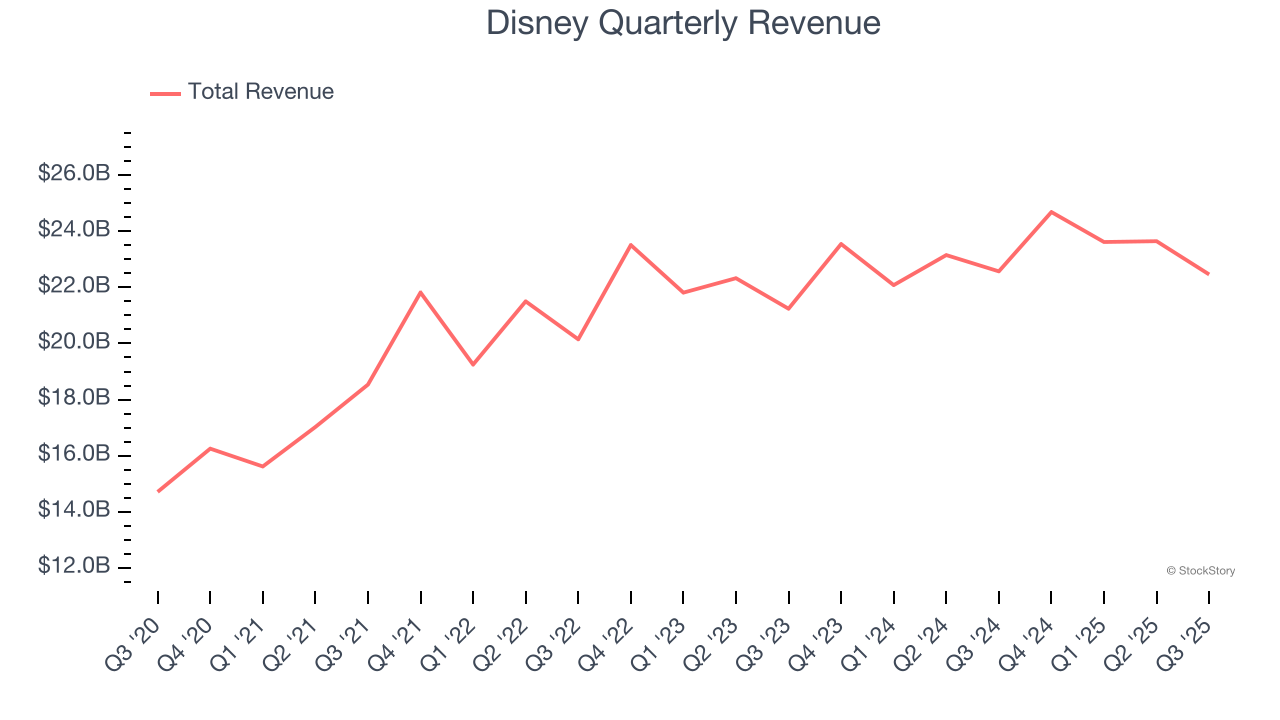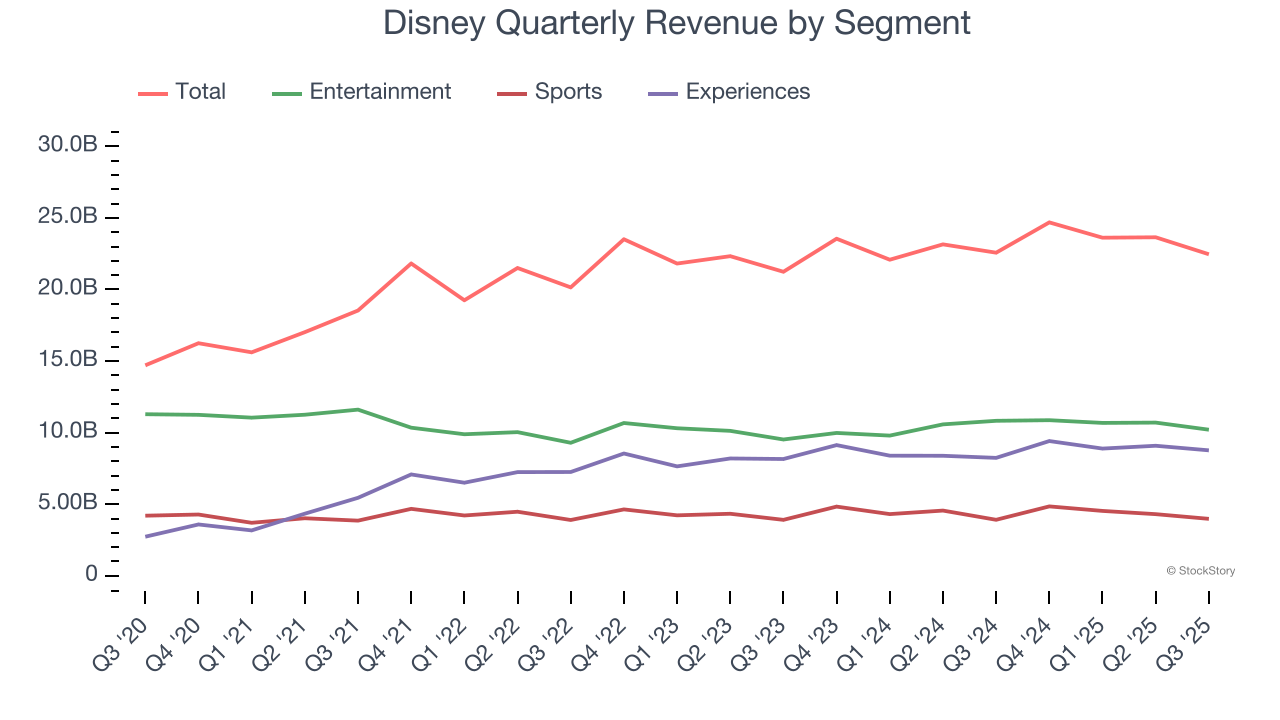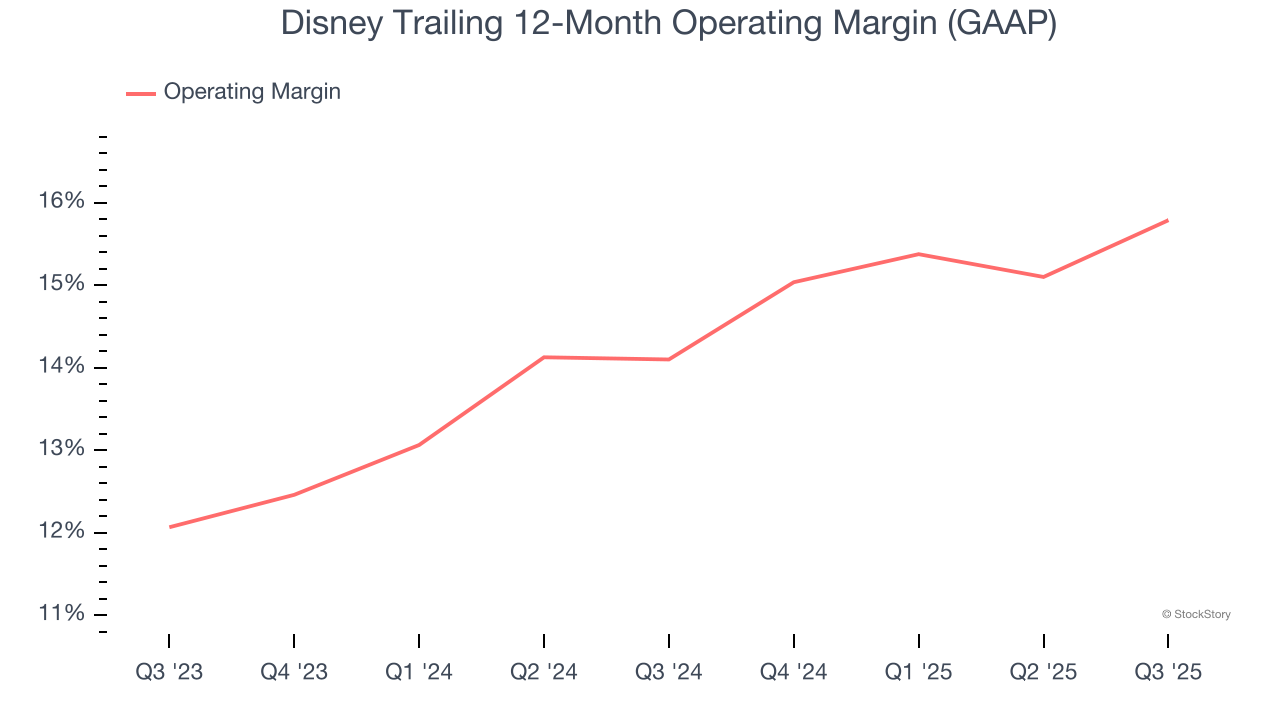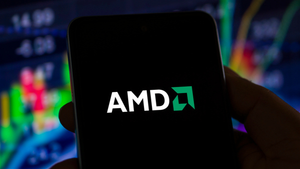
Global entertainment and media company Disney (NYSE: DIS) fell short of the markets revenue expectations in Q3 CY2025, with sales flat year on year at $22.46 billion. Its non-GAAP profit of $1.11 per share was 8.4% above analysts’ consensus estimates.
Is now the time to buy Disney? Find out by accessing our full research report, it’s free for active Edge members.
Disney (DIS) Q3 CY2025 Highlights:
- Revenue: $22.46 billion vs analyst estimates of $22.75 billion (flat year on year, 1.3% miss)
- Adjusted EPS: $1.11 vs analyst estimates of $1.02 (8.4% beat)
- Operating Margin: 15.5%, up from 12.6% in the same quarter last year
- Free Cash Flow Margin: 11.4%, down from 17.8% in the same quarter last year
- Disney+ added 3.8 million subscribers during the period, bringing its total to 131.6 million (beat)
- Market Capitalization: $209.7 billion
Company Overview
Founded by brothers Walt and Roy, Disney (NYSE: DIS) is a multinational entertainment conglomerate, renowned for its theme parks, movies, television networks, and merchandise.
Revenue Growth
Reviewing a company’s long-term sales performance reveals insights into its quality. Any business can put up a good quarter or two, but many enduring ones grow for years. Regrettably, Disney’s sales grew at a sluggish 7.6% compounded annual growth rate over the last five years. This fell short of our benchmark for the consumer discretionary sector and is a tough starting point for our analysis.

We at StockStory place the most emphasis on long-term growth, but within consumer discretionary, a stretched historical view may miss a company riding a successful new product or trend. Disney’s recent performance shows its demand has slowed as its annualized revenue growth of 3.1% over the last two years was below its five-year trend. 
We can better understand the company’s revenue dynamics by analyzing its three most important segments: Entertainment, Sports, and Experiences, which are 45.4%, 17.7%, and 39% of revenue. Over the last two years, Disney’s revenues in all three segments increased. Its Entertainment revenue (movies, Disney+) averaged year-on-year growth of 2.5% while its Sports (ESPN, SEC Network) and Experiences (theme parks) revenues averaged 1.6% and 5.5%. 
This quarter, Disney missed Wall Street’s estimates and reported a rather uninspiring 0.5% year-on-year revenue decline, generating $22.46 billion of revenue.
Looking ahead, sell-side analysts expect revenue to grow 6.4% over the next 12 months. While this projection implies its newer products and services will catalyze better top-line performance, it is still below average for the sector.
Software is eating the world and there is virtually no industry left that has been untouched by it. That drives increasing demand for tools helping software developers do their jobs, whether it be monitoring critical cloud infrastructure, integrating audio and video functionality, or ensuring smooth content streaming. Click here to access a free report on our 3 favorite stocks to play this generational megatrend.
Operating Margin
Operating margin is an important measure of profitability as it shows the portion of revenue left after accounting for all core expenses – everything from the cost of goods sold to advertising and wages. It’s also useful for comparing profitability across companies with different levels of debt and tax rates because it excludes interest and taxes.
Disney’s operating margin has risen over the last 12 months and averaged 15% over the last two years. Its solid profitability for a consumer discretionary business shows it’s an efficient company that manages its expenses effectively.

This quarter, Disney generated an operating margin profit margin of 15.5%, up 2.9 percentage points year on year. This increase was a welcome development and shows it was more efficient.
Earnings Per Share
We track the long-term change in earnings per share (EPS) for the same reason as long-term revenue growth. Compared to revenue, however, EPS highlights whether a company’s growth is profitable.
Disney’s EPS grew at a spectacular 24.2% compounded annual growth rate over the last five years, higher than its 7.6% annualized revenue growth. This tells us the company became more profitable on a per-share basis as it expanded.

In Q3, Disney reported adjusted EPS of $1.11, down from $1.14 in the same quarter last year. Despite falling year on year, this print beat analysts’ estimates by 8.4%. Over the next 12 months, Wall Street expects Disney’s full-year EPS of $5.93 to grow 9.4%.
Key Takeaways from Disney’s Q3 Results
Disney+, the company's flagship streaming service, added 3.8 million subscribers, above expectations. We were also glad its EPS outperformed Wall Street’s estimates. On the other hand, its Entertainment revenue missed and its revenue fell slightly short of Wall Street’s estimates. The traditional, linear TV segment is struggling. Overall, we think this quarter could have been better. Despite the solid streaming results, the market seemed to be hoping for more, and the stock traded down 3.1% to $113.13 immediately after reporting.
Big picture, is Disney a buy here and now? What happened in the latest quarter matters, but not as much as longer-term business quality and valuation, when deciding whether to invest in this stock. We cover that in our actionable full research report which you can read here, it’s free for active Edge members.





